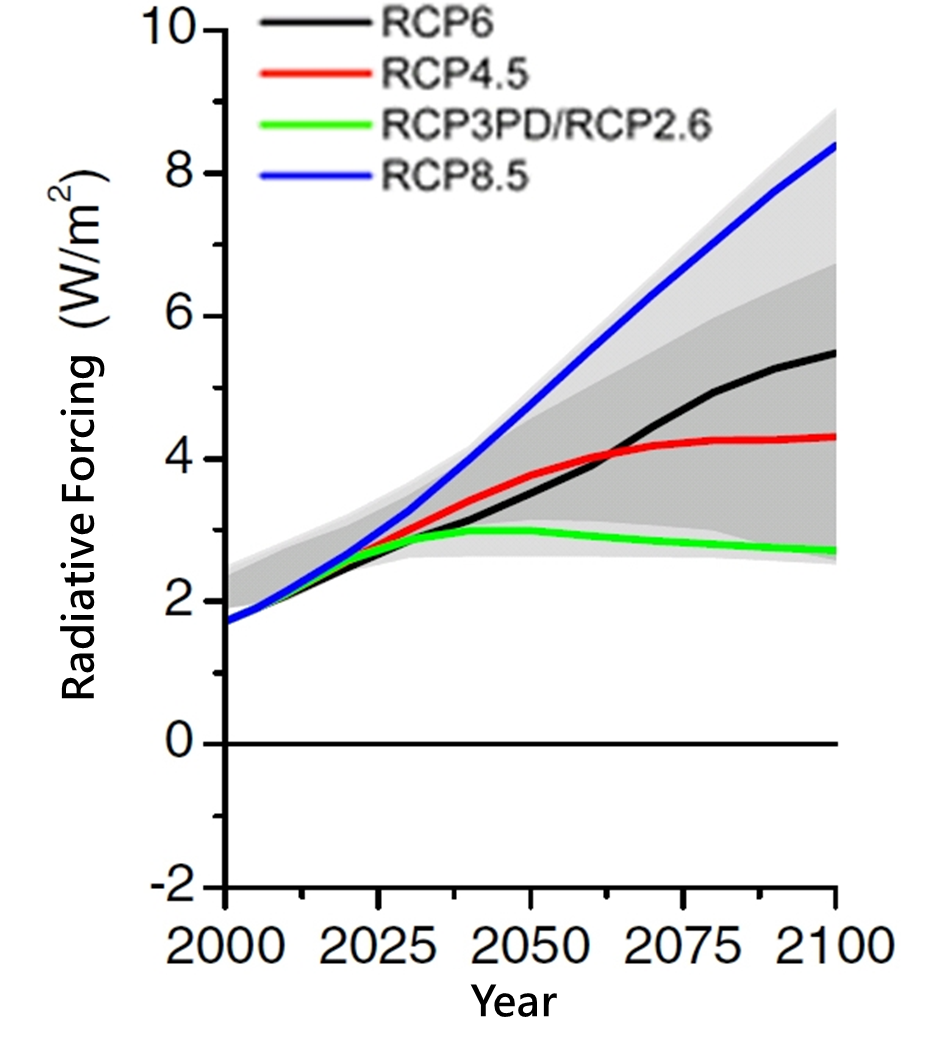Data Service / Projection
Representative Concentration Pathways (RCPs)
In the climate change assessment by the IPCC Working Group I, it is necessary to describe the information on the future emissions or concentrations of greenhouse gases, aerosols, and other climate drivers, which are usually expressed in terms of human activity scenarios.
The scenarios considered by the IPCC do not include changes in natural drivers such as the sun, volcanoes, or methane and nitrous oxide from nature, and only focus on anthropogenic emissions.
In the IPCC Fifth Assessment Report, four sets of future change scenarios are redefined by 「representative concentration pathways'(RCPs)」 (pathways refer to the concentration change process), and are distinguished by the indicator value of the difference in radiative forcing between 2100 and 1750.
The scenario named RCP2.6 means that the radiative forcing per square meter increased by 2.6 watts in 2100, while RCP4.5, RCP6.0 and RCP8.5 represent the radiative forcing per square meter increased by 4.5, 6.0 and 8.5 watts respectively. Among these four scenarios, RCP2.6 is a warming mitigation scenario (radiative forcing shows a decreasing trend in 2100); RCP4.5 and RCP6.0 are stable scenarios (radiative forcing changes show a relatively stable state in 2100); RCP8.5 is a high greenhouse gas emission scenario (radiative forcing shows a continuous increasing trend in 2100).
Compared with the scenarios considered in the Third Assessment Report and the Fourth Assessment Report, these four scenarios cover a wider range of aspects. In addition to setting the annual greenhouse gas concentrations, each RCP can estimate the anthropogenic greenhouse gas emissions based on the combination calculation of integrated assessment models, simplified climate models, atmospheric chemistry models and global carbon cycle models, and provide the spatial distribution of land use change and the regional air pollutant emissions. Although these RCP scenarios cover a wide range of radiative forcing, they still have some shortcomings, especially related to aerosols.
Most of the CMIP5 models and Earth system models use the greenhouse gas concentration changes set by each RCPs scenario to perform climate projection simulations.
By 2100, under the RCP2.6 scenario, the concentration of carbon dioxide will reach 421 ppm; under the RCP4.5 scenario, it will reach 538 ppm; under the RCP6.0 scenario, it will reach 670 ppm; and under the RCP8.5 scenario, it will reach 936 ppm.
If the equivalent carbon dioxide concentration derived from the overall effect of all greenhouse gases is considered: under the RCP2.6 scenario, the equivalent carbon dioxide concentration will reach 475 ppm; under the RCP4.5 scenario, it will reach 630 ppm; under the RCP6.0 scenario, it will reach 800 ppm; and under the RCP8.5 scenario, it will reach 1313 ppm.
In addition to using greenhouse gas concentrations, some Earth system models also added preset carbon dioxide emissions in the simulation and performed some additional climate projection simulations for RCP8.5. In addition, the latest atmospheric chemistry data and coupled models were also used to perform additional simulations for the four RCPs.

References
- The Representative Concentration Pathways: An Overview. Climatic Change (2011), 109, 5-31. DOI 10.1007/s10584-011-0148-z
